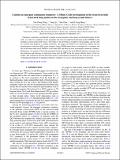Caution on emergent continuous symmetry: A Monte Carlo investigation of the transverse-field frustrated Ising model on the triangular and honeycomb lattices
Author(s)
Wang, Yan-Cheng; Qi, Yang; Chen, Shu; Meng, Zi Yang
DownloadPhysRevB.96.115160.pdf (1.259Mb)
PUBLISHER_POLICY
Publisher Policy
Article is made available in accordance with the publisher's policy and may be subject to US copyright law. Please refer to the publisher's site for terms of use.
Terms of use
Metadata
Show full item recordAbstract
Continuous symmetries are believed to emerge at many quantum critical points in frustrated magnets. In this work, we study two candidates of this paradigm: the transverse-field frustrated Ising model (TFFIM) on the triangular and the honeycomb lattices. The former is the prototypical example of this paradigm, and the latter has recently been proposed as another realization. Our large-scale Monte Carlo simulation confirms that the quantum phase transition (QPT) in the triangular lattice TFFIM indeed hosts an emergent O(2) symmetry, but that in the honeycomb lattice TFFIM is a first-order QPT and does not have an emergent continuous symmetry. Furthermore, our analysis of the order-parameter histogram reveals that such different behavior originates from the irrelevance and relevance of anisotropic terms near the QPT in the low-energy effective theory of the two models. The comparison between theoretical analysis and numerical simulation in this work paves the way for scrutinizing investigation of emergent continuous symmetry at classical and quantum phase transitions.
Date issued
2017-09Department
Massachusetts Institute of Technology. Department of PhysicsJournal
Physical Review B
Publisher
American Physical Society
Citation
Wang, Yan-Cheng, et al. “Caution on Emergent Continuous Symmetry: A Monte Carlo Investigation of the Transverse-Field Frustrated Ising Model on the Triangular and Honeycomb Lattices.” Physical Review B, vol. 96, no. 11, Sept. 2017.
Version: Final published version
ISSN
2469-9950
2469-9969